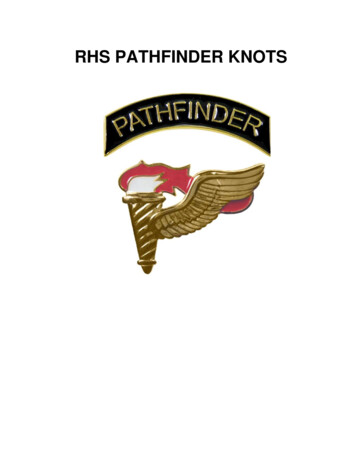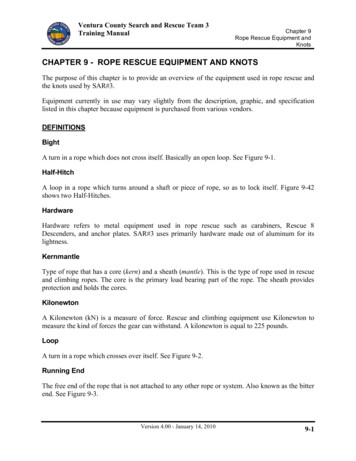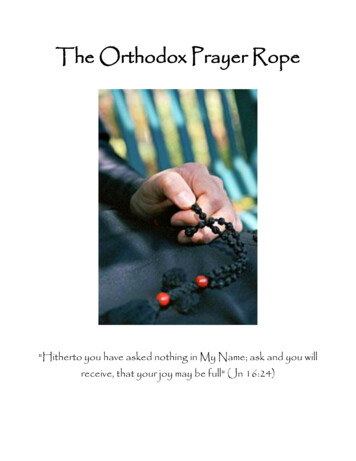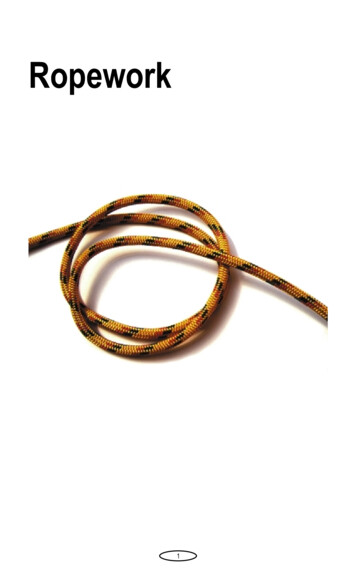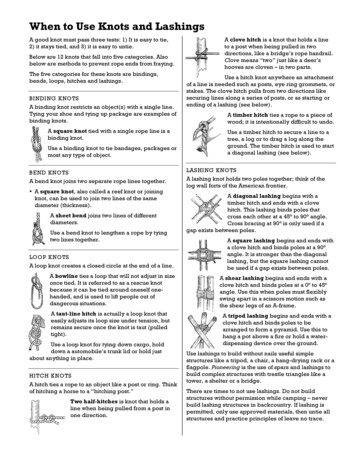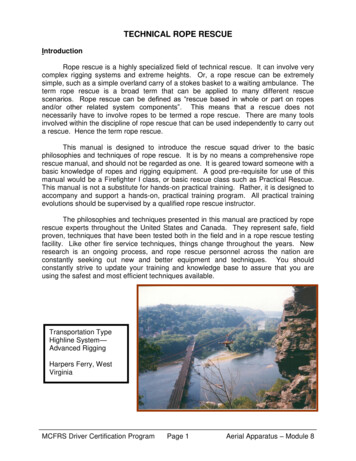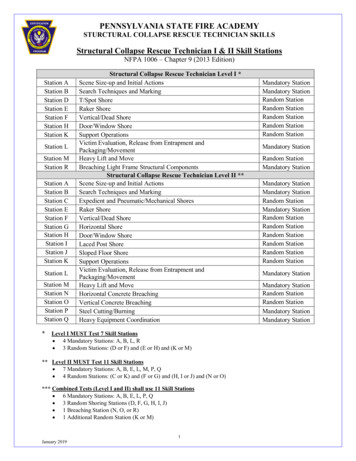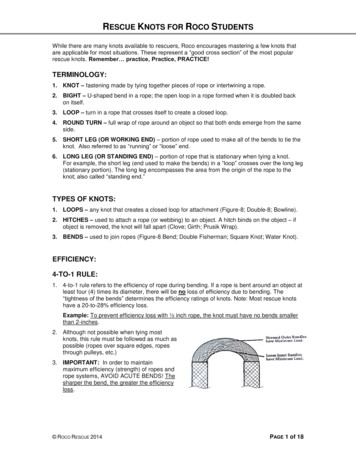
Transcription
RESCUE KNOTS FOR ROCO STUDENTSWhile there are many knots available to rescuers, Roco encourages mastering a few knots thatare applicable for most situations. These represent a “good cross section” of the most popularrescue knots. Remember practice, Practice, PRACTICE!TERMINOLOGY:1. KNOT – fastening made by tying together pieces of rope or intertwining a rope.2. BIGHT – U-shaped bend in a rope; the open loop in a rope formed when it is doubled backon itself.3. LOOP – turn in a rope that crosses itself to create a closed loop.4. ROUND TURN – full wrap of rope around an object so that both ends emerge from the sameside.5. SHORT LEG (OR WORKING END) – portion of rope used to make all of the bends to tie theknot. Also referred to as “running” or “loose” end.6. LONG LEG (OR STANDING END) – portion of rope that is stationary when tying a knot.For example, the short leg (end used to make the bends) in a “loop” crosses over the long leg(stationary portion). The long leg encompasses the area from the origin of the rope to theknot; also called “standing end.”TYPES OF KNOTS:1. LOOPS – any knot that creates a closed loop for attachment (Figure-8; Double-8; Bowline).2. HITCHES – used to attach a rope (or webbing) to an object. A hitch binds on the object – ifobject is removed, the knot will fall apart (Clove; Girth; Prusik Wrap).3. BENDS – used to join ropes (Figure-8 Bend; Double Fisherman; Square Knot; Water Knot).EFFICIENCY:4-TO-1 RULE:1. 4-to-1 rule refers to the efficiency of rope during bending. If a rope is bent around an object atleast four (4) times its diameter, there will be no loss of efficiency due to bending. The“tightness of the bends” determines the efficiency ratings of knots. Note: Most rescue knotshave a 20-to-28% efficiency loss.Example: To prevent efficiency loss with ½ inch rope, the knot must have no bends smallerthan 2-inches.2. Although not possible when tying mostknots, this rule must be followed as much aspossible (ropes over square edges, ropesthrough pulleys, etc.)3. IMPORTANT: In order to maintainmaximum efficiency (strength) of ropes andrope systems, AVOID ACUTE BENDS! Thesharper the bend, the greater the efficiencyloss. ROCO RESCUE 2014PAGE 1 of 18
RESCUE KNOTS FOR ROCO STUDENTSSTEPS IN KNOT TYING:1. DRESS Try to keep the ropes free of twists – with legs running side-by-side.2. LOAD Once tied, the knot should be pulled tight to avoid any accidental movement whenline is loaded. TEST LOAD before life-loading!3. SAFETY Refers to securing any loose ends. If knot has a loose end (tail), it should besecured using another knot (a safety knot).4. PRACTICE Most important concept in tying knots Practice!!1. OVERHAND KNOT:Purpose: Used as a Safety Knotto secure loose ends.OPTIONAL KNOTBarrel Knot as a safetyPurpose: Used as a safety knot to secure loose ends.This knot, when used as a safety, is less likely to untie. It is used as a safety knot for hitches, whenrunning a loaded knot over an edge or when the knot will see tensioning and slacking of the linerepeatedly. ROCO RESCUE 2014PAGE 2 of 18
RESCUE KNOTS FOR ROCO STUDENTS2. FIGURE-8 STOPPER KNOT:Purpose: Used to stoprope end from movingthrough a device (rappelrack, etc.).Figure-8 Stopper Knot3. FIGURE-8 ON-A-BIGHT:Purpose: Anchor knot that creates a single loop that will not slip. It can be attached tocomponents of a rescue system with carabiners.Efficiency loss: approximately 20%Figure-8 on-a-bight ROCO RESCUE 2014PAGE 3 of 18
RESCUE KNOTS FOR ROCO STUDENTS4. DOUBLE-LOOP FIGURE-8:Purpose: Anchor knot that provides more load-bearing surface area due to its two-loopconfiguration. It is slightly more efficient when you must tie around a tight object such as acarabiner.Efficiency loss: approximately 18%Double-Loop Figure-8 ROCO RESCUE 2014PAGE 4 of 18
RESCUE KNOTS FOR ROCO STUDENTS5. BOWLINE KNOT:Purpose: May be used as a static (non-moving) anchor knot.Efficiency loss: approximately 27% to 33%WARNING A bowline knot should NEVER be used in moving applications because it canuntie when going over an edge. Always safety the loose end!Bowline KnotAlways safety the loose end!6. DOUBLED BOWLINE KNOT:Purpose: May be used as a static (non-moving) anchor knot that can be tied in the middle of aline. It is a simple Bowline tied with a bight in the line.WARNING The bowline knot is not recommended to be used in moving applicationsbecause it can untie when going over an edge. Always safety the loose end!Doubled Bowline ROCO RESCUE 2014PAGE 5 of 18
RESCUE KNOTS FOR ROCO STUDENTS7. FIGURE-8 FOLLOW-THROUGH KNOT:Purpose: Anchor knot that can be tied around an anchor or a “closed-end” object.Efficiency loss: approximately 20%Figure-8 Follow-Through Knot ROCO RESCUE 2014PAGE 6 of 18
RESCUE KNOTS FOR ROCO STUDENTS8. CLOVE HITCH:Purpose: Adjustable anchor hitch often tied to round anchorpoints (horizontally or vertically). It may also be tied withwebbing.Efficiency loss: approximately 40%Clove Hitch (end line)Clove Hitch (mid-line) ROCO RESCUE 2014PAGE 7 of 18
RESCUE KNOTS FOR ROCO STUDENTS9. TENSIONLESS ANCHOR (4-TO-1 WRAP):Purpose: Most efficient means of anchoring a rope – as long as it’s wrapped around a secureanchor at least 4 times the diameter of the rope.1.2.3.4.Turns of the rope should not cross each other.Minimum of three wraps.Must be finished with a knot.May roll on round, smooth anchors.Efficiency loss: 0%Tensionless Anchor (4-to-1 Wrap) ROCO RESCUE 2014PAGE 8 of 18
RESCUE KNOTS FOR ROCO STUDENTS10. GIRTH HITCHPurpose: Used to anchor rope or webbing as a “choker.” It is the preferred method of attachinga piece of webbing to the foot-end of a backboard or metal litter when using a “Diamond Weave”to lash a patient.Efficiency loss: approximately 30%Girth Hitch ROCO RESCUE 2014PAGE 9 of 18
RESCUE KNOTS FOR ROCO STUDENTS11. BUTTERFLY KNOT:Purpose: Bridle knot that provides a mid-line attachment point and is designed to take a threedirectional pull.Efficiency loss: approximately 25%13254786Butterfly Knot ROCO RESCUE 2014PAGE 10 of 18
RESCUE KNOTS FOR ROCO STUDENTSOptional Knot12. DOUBLE BUTTERFLY KNOT:Purpose: provides more surface area round attachment hasp by forming a double loop much likethe double loop -8The knot is tied by forming four loops around your hand instead of three. Then picking up thecenter two loops instead of the center one and pulling both center loops back toward the thumband out under the remaining two loops. Finish knot as usual.Double Butterfly ROCO RESCUE 2014PAGE 11 of 18
RESCUE KNOTS FOR ROCO STUDENTS13. DOUBLE FISHERMAN’S BEND:Purpose: Used to join two ropes of equal (or slightly unequal) diameter together for load-bearingapplications. (Usually used to form prusik loops)Efficiency loss: approximately 21%Double Fisherman’s Bend14. FIGURE-8 BEND KNOT:Purpose: To join two ropes togetherfor load bearing purposes.Efficiency loss: approximately 19% ROCO RESCUE 2014PAGE 12 of 18
RESCUE KNOTS FOR ROCO STUDENTS15. SQUARE KNOT:Purpose: Used to “bind” two ropes of the same diameter together.WARNING Square knots should not be used in load-bearing applications or to supporta human load! Always safety the loose ends.When finished, both tail ends must emerge from the same side of knot. If the rope ends emergefrom opposite sides (one top, one bottom), it is not a square knot and will slip more easily when aforce is applied.Square KnotAlways safety loose ends! ROCO RESCUE 2014PAGE 13 of 18
RESCUE KNOTS FOR ROCO STUDENTS16. WATER KNOT:Purpose: Preferred method for joining two pieces of webbing for load-bearing applications.Efficiency loss: approximately 35% ROCO RESCUE 2014PAGE 14 of 18
RESCUE KNOTS FOR ROCO STUDENTS17. MUNTER HITCH:Purpose: Used primarily as a “belay hitch” – allows belayer to catch a falling load when properlyoperated. Predominantly used for Technical use loads and recommended if using for General useloads that another rescuer assist as a body belay.Munter Hitch18. MULE KNOT:Purpose: Used as a secure, easy to release “tie-off” to prevent rope from feeding through adevice, munter hitch or carabiner wrap.Mule Knot ROCO RESCUE 2014PAGE 15 of 18
RESCUE KNOTS FOR ROCO STUDENTS19. WEBBING ADJUSTMENT TECHNIQUEPurpose: Used to adjust the length of tubular webbing once it has been looped and doubledaround an anchor.a. Place webbing looped with a water knot around an anchor.b. Grab both loops with your right hand in the thumbs down position.c. Place left hand through both loops.d. Rotate right hand from thumbs down to thumbs up position.e. Hook loop leg on left thumb and pull leg back out with left arm.f.Work both loops out as you move closer to anchor.g. This will allow you to adjust the webbing up to half the distance to the anchor.h. Once webbing is at desired length, place a carabiner through all loops.Note: These steps can be repeated to half the webbing again. ROCO RESCUE 2014PAGE 16 of 18
RESCUE KNOTS FOR ROCO STUDENTS20. DAISY CHAIN Purpose: Storing or transporting rope or webbing. ROCO RESCUE 2014PAGE 17 of 18
RESCUE KNOTS FOR ROCO STUDENTS21. DOUBLE-WRAP PRUSIK HITCH:Purpose: Used for hauling, ascending and self-rescue. It is formed using a “prusik” loop of asmaller diameter accessory cord wrapped around a larger diameter rope. The prusik acts as a“rope grab” on the larger rope. The accessory cord should be about 4mm smaller than the rope(or about one-half to three-quarters the size of the rope).1. OVERHAND KNOT:Purpose: Used as a Safety Knotto secure loose ends.Double-Wrap Prusik Hitch ROCO RESCUE 2014PAGE 18 of 18
rescue knots. Remember practice, Practice, PRACTICE! TERMINOLOGY: 1. KNOT – fastening made by tying together pieces of rope or intertwining a rope. 2. BIGHT – U-shaped bend in a rope; the open loop in a rope formed when it is doubled back on itself. 3. LOOP – turn in a rope
